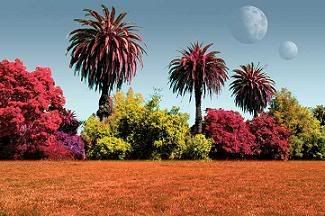Post by glactus on Mar 8, 2008 1:26:12 GMT

We've already found over 250 extrasolar planets, and more are continuing to be discovered fairly often. With all of these new planets popping up, the obvious question must be asked: how do we go about detecting whether or not they contain life?
Though we can't yet see features on the surface with even the most powerful of telescopes – and probably won't be able to do so for a very long time – an analysis of the light coming from the planet may reveal if it is covered with life in the form of plants.
Dr. Luc Arnold of the CNRS Observatoire de Haute-Provence in France suggests that a spectral analysis of the light reflected off of a planet could determine whether or not it is covered with vegetation.
By looking at the sunlight that is reflected off of the Earth – Earthshine – the composition of the Earth's surface and atmosphere can be determined. The Earth's light can be analyzed when it is reflected off of the Moon, or from spacecraft distant enough from the Earth to see it as a small disk.
Knowing the composition of the Sun's light, and adjusting for the elements and minerals in the atmosphere and on the surface, there is still between 0-10% of the photons near the red end of the visible spectrum that are missing.
The factor needed to explain this photon absorption is the presence of plants, which use the light for photosynthesis
This same method could potentially be used to detect the presence of vegetation on extrasolar planets, proposes Dr. Arnold in a paper titled, Earthshine Observation of Vegetation and Implication for Life Detection on Other Planets published in the October 30th, 2007 edition of the journal Space Science Review.

Art planets
credits:
original source: Space Science Review filed under Astrobiology, Extrasolar Planets.
image: www.universetoday.com/wp-content/uploads/2007/12/2007-1205plants.jpg
This is part text only. See image, full text and all scientists involved at universetoday.com.com
www.universetoday.com/2007/12/05/could-we-detect-plants-on-other-planets/#more-12171
article credit: Nicholos Wethington



